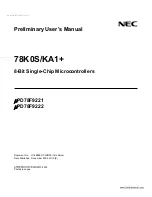
15.8.12.2 0-Bit Data Delay
Normally, a frame-synchronization pulse is detected or sampled with respect to an edge of serial clock internal
CLK(R/X). Thus, on the following cycle or later (depending on the data delay value), data can be received or
transmitted. However, in the case of 0-bit data delay, the data must be ready for reception and/or transmission
on the same serial clock cycle.
For reception this problem is solved because receive data is sampled on the first falling edge of MCLKR where
an active-high internal FSR is detected. However, data transmission must begin on the rising edge of the internal
CLKX clock that generated the frame synchronization. Therefore, the first data bit is assumed to be present in
XSR1, and thus DX. The transmitter then asynchronously detects the frame synchronization, FSX, going active
high and immediately starts driving the first bit to be transmitted on the DX pin.
15.8.12.3 2-Bit Data Delay
A data delay of two bit-periods allows the serial port to interface to different types of T1 framing devices where
the data stream is preceded by a framing bit. During reception of such a stream with data delay of two bits
(framing bit appears after a 1-bit delay and data appears after a 2-bit delay), the serial port essentially discards
the framing bit from the data stream, as shown in the following figure. In this figure, the data transferred is an
8-bit value with bits labeled B7, B6, B5, and so on.
DR
Framing bit
B5
B6
B7
FSR
CLKR
Á
Á
Á
Á
2-bit delay
Figure 15-57. 2-Bit Data Delay Used to Skip a Framing Bit
Multichannel Buffered Serial Port (McBSP)
SPRUH18I – JANUARY 2011 – REVISED JUNE 2022
TMS320x2806x Microcontrollers
947
Copyright © 2022 Texas Instruments Incorporated
Содержание TMS320 2806 Series
Страница 2: ......















































